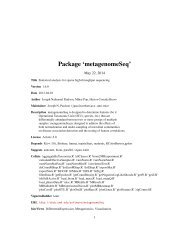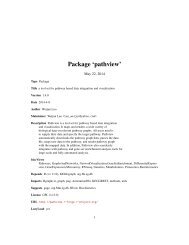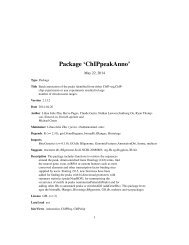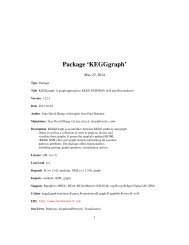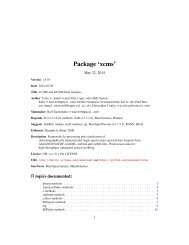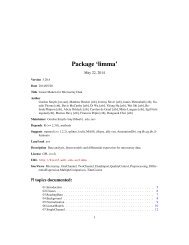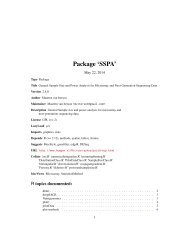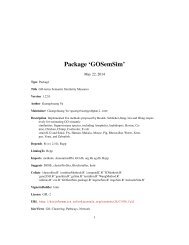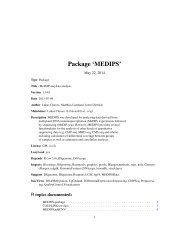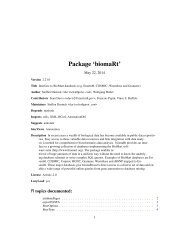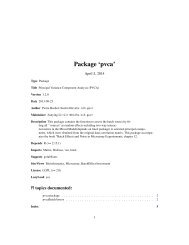Package 'charm' - Bioconductor
Package 'charm' - Bioconductor
Package 'charm' - Bioconductor
Create successful ePaper yourself
Turn your PDF publications into a flip-book with our unique Google optimized e-Paper software.
32 qval<br />
fwer.num<br />
statistic, where the null distribution is obtained by simply pooling together all<br />
the statistic vectors from all iterations. If "fwer", the resulting table will have an<br />
additional column ("pvalue.fwer") with the p-value adjusted for control of the<br />
family-wise error rate (obtained as the proportion of maximum statistics (across<br />
all iterations) that are greater than or equal to the observed statistic). More than<br />
one value for method may be specified.<br />
positive integer vector, needed if method argument includes "fwer". For each<br />
number, a separate output column will be returned with the FWER(n)-controlling<br />
adjusted p-values, where FWER(n) is defined as the probability of making n or<br />
more false discoveries (type I errors).<br />
Details<br />
The q-value for region i is estimated by a resampling procedure. It is estimated as x/N, where N is<br />
the number of dmrs in the DMR table returned by dmrFind whose statistic (defined by the sortBy<br />
argument to dmrFind) is >= the statistic for region i, and x is the average (across all iterations’ DMR<br />
tables) number of DMRs with statistic >= the statistic for region i. Monotonicity is then enforced<br />
and q-values are capped at 1. For example, to estimate the q-value for the 5th dmr in your dmr<br />
table that you ranked by area, N is 5. If it has area=100, then x is the average number of dmrs with<br />
area>=100, averaging over all the tables produced by random-resampling iterations. To the extent<br />
that the proportion of the genome covered by the array that is truly non-differentially methylated<br />
is less than 1, x will slightly overestimate the true number of false DMR candidates expected to be<br />
returned from the data, and hence the q-value will be slightly conservative.<br />
The resampling procedure used to obtain null data for each iteration is as follows. 1. Add the<br />
surrogate variables identified by SVA to the null model defined by the mod0 argument to dmrFind,<br />
and obtain fitted methylation values M, where rows correspond to probes and columns correspond<br />
to arrays. 2. Add the surrogate variables identified by SVA to the full model defined by the mod<br />
argument to dmrFind, and obtain residuals R, where rows correspond to probes and columns correspond<br />
to arrays. Then, for iteration k, obtain a column-resampled version of R, Q (resampling with<br />
replacement), and obtain the methylation values to be used in iteration k as M+Q.<br />
Value<br />
the dmr table in your dmr object (dmr$dmrs), with an additional column ("qvalue") for the Fdr q-<br />
value (if method includes "direct"), additional columns for the pooled estimates of the p-values and<br />
q-values (if method includes "pool"), and an additional column for the FWER-adjusted p-values (if<br />
method includes "fwer") (see method argument). There is also a column called qvalue0 which is<br />
just the qvalue column before enforcing monotonicity.<br />
Author(s)<br />
Martin Aryee, Peter Murakami , Rafael Irizarry<br />
See Also<br />
dmrFind, plotDMRs, plotRegions



